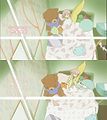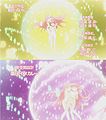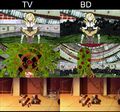Episode revisions
The series was released several times over the time:
- the original broadcasts on MBS and TBS
- one week late broadcast on CBC
- webcast on Nico Nico Douga, Showtime and AnimeOne
- three months late broadcast on AT-X
- DVD/BD release
This page is a work-in-progress attempt to list at least some of the changes made to the episodes in later revisions.
Opening sequence
The original version of the opening sequence was used only in the broadcast versions of first two episodes. Later releases feature slightly modified versions of it.
Episode 3 version
Episode 4-5, 7-9 version
This version is almost identical to the episode 3's version. The only difference is the color of rain smudges on Madoka's window in the shot featuring her in bed.
Episode 6 version
This version was used only in Episode 6. It differs from the more common version in the far shot of Madoka's transformation, which now features a background in alternating colors instead of solid yellow. Subsequent closeup shots are left unchanged.
Episode 10-11 version
This version is identical to the version used in episodes 4, 5 and 7 through 9, except that the final shot now features Homura and Kyouko.
Note that in Episode 10, the usual opening sequence is used as the ending sequence (the episode lacks a proper opening sequence), and thus features a different credits roll.
Blu-ray version
The version used on Blu-ray releases (and available in a credits-free version on Blu-ray Volume 1) is very similar to the one used in the broadcast version of Episode 6. There are some further changes, however:
- Closeup shots of Madoka's transformation scene now feature multi-colored background, like the first shot, and the biggest rune chain now casts a shadow.
- The subsequent scene, where Madoka is running through the city, is now brighter, and feature shading on Madoka's drawing instead of flat-filled colors seen in previous versions.
Episode 1
The original version premiered on MBS on January 6.
Webcast version
This version was first shown on Nico Nico Douga on January 12. The same version was later shown on other streaming sites and rebroadcast on AT-X on April 2.
- In the original broadcast, all the background music (most notably, Magia played during the prologue scene) is played slower and at a lower pitch. In the AT-X version (and reportedly the webcast version, too), this was corrected, causing the need for the tunes to be edited differently to fit the video.[1]
Blu-ray version
This version of the episode was released with the Blu-ray Volume 1 on April 27.
Some of those differences were first pointed on Amimone☆Nikki, a Japanese fan's blog.
- There are many slight lighting changes throughout the whole episode.
- There are many slight voice timing corrections throughout the whole episode (some lines are moved by fractions of second compared to the original version).
- The prologue scene was heavily modified, to keep it in line with Timeline 4 of Episode 10.
- A new version of the opening sequence is used.
- In mother waking scene, a mannequin near the bed has been removed.
- Direction of sunlight is changed in some shots of the walk to school.
- Girls' shadows are drawn in more detail in other shots of the same scene.
- Closeup shot of the teacher is re-animated.
- During Homura's introduction, her name on the whiteboard is moved to be visible.
- Sayaka's hairpin is removed (it was mistakenly drawn on the wrong side) in one of the shots in the classroom.
- Lighting is dimmed in Homura's high jump shot.
- Sayaka and Hitomi are shown giggling upon hearing Madoka saying she met Homura in her dream. Previous versions featured just a still picture.
- Lights glow in Kyubey chase scene is changed.
- A fence is added before Madoka in the shot where she meets Kyubey.
- Lines on Madoka's cheeks are less intense in a closeup shot of her afterwards.
- When Gertrud's barrier first appears, the images and runes are more clearly visible, the translucent "screen" is removed for most part, and smooth wipes are replaced by sharp cuts.
- Runes shown when Anthonies are reciting a poem in German are changed. It now features the so-called archaic script instead of the modern one and an entirely different text.
- The explosion in Gertrud's maze is animated completely differently.
- Mami's Soul Gem in her first shot is much smaller, and has little flowers sparkling around it.
- Mami is lit differently in a shot before her transformation.
- During Mami's transformation, Soul Gem has different shape and is glowing more intensively. The whole transformation sequence is also brighter.
- Final explosion of the fight is significantly brighter.
- During the talk between Homura and Mami after the fight, additional chains hanging from the ceiling are drawn.
- The episode has a proper ending sequence with an entirely new song.
Below is a screenshot comparison between the original broadcast version and the Blu-ray release of the episode:
Episode 2
The original version premiered on MBS on January 13 and was later published on web distributions sites on January 19 and rebroadcast on AT-X on April 9 without changes.
Blu-ray version
Some of those differences were pointed on Amimone☆Nikki.
- Like in Episode 1, many voice lines have been re-timed.
- Pre-OP scene of Mami's fight and introduction is lit brighter.
- A new version of the opening sequence is used, like in Episode 1.
- Reflections in the mirror during the bath scene are much brighter.
- Interior of Mami's apartment is redesigned completely, with a round table and many stuff inside (see picture on the right). Note that some of these changes could be already seen in Episode 10.
- Mami's Soul Gem is bigger when she shows it to the second-years.
- In the original print of the Blu-ray discs, there is a production error consisting of Mami's line "They [Soul Gems] are created when a girl chosen by Kyubey forms a contract" mistakenly replaced by a repeat of her earlier line "Being chosen by Kyubey means you're involved in this", which she said as one of first lines during the girls' visit. The mistake is likely due to two lines beginning with the same words (「キュゥべぇに選ばれた」) in Japanese. The defective version has already been recalled by Aniplex due to this issue and wrong lyrics of the character song printed in the booklet.
- Some shots inside Mami's apartment have characters redrawn in addition to a completely different background.
- Color of the sunset behind Mami's windows is different.
- Madoka is visible in some of the shots of Junko before the mirror.
- Shot of Mami's reflection in the table is zoomed out, showing much more detail.
- Madoka's face is lit differently during a closeup shot in Mami's apartment.
- Closeups of Mami's Soul Gem show a slightly different design of it.
- Fence on the school rooftop has a different pattern.
- Flash of Kyousuke's room now features a dark sunset or sunrise. He is also sitting straight, instead of laying down.
- When the girls go on a witch hunt, the lighting is darker, and blooming cherry trees are replaced by dead trees. The bridges also have different designs.
- The woman who jumps off the bridge has darker hair.
- The floor of the building where Gertrud is hiding is now patterned.
- Some shots inside the witch's barrier have different lighting.
- A place before entrance to Gertrud's chamber looks different.
- The witch's chamber feature more flowers in the background.
- Gertrud's name (in runes) is written in a smaller and differently colored font.
- The witch's movements after Mami is tied up and before she attcks with Tiro Finale, are different.
- Magical attacks during the fight have a brighter glow. In one shot there are also flowers sparkling around the beams.
- The ending sequence is added, like in Episode 1.
Below is a screenshot comparison between the original broadcast version and the Blu-ray release of the episode:
Episode 3
The original version premiered on MBS on January 20.
Episode 4
The original version premiered on MBS on January 27.
AT-X version
- Elly's Grief Seed is shown after the fight.
Episode 5
The original version premiered on MBS on February 3.
Episode 6
The original version premiered on MBS on February 10.
Episode 7
The original version premiered on MBS on February 17.
Episode 8
The original version premiered on MBS on February 24.
Episode 9
The original version premiered on MBS on March 3.
Episode 10
The original version premeried on MBS on March 10. Next day was the Great East Japan Earthquake, causing the episode not to be aired on TBS and starting the six-week-long hiatus for the series.
Webcast version
This version premiered on Nico Nico Douga on March 16. It features several updates compared to the original broadcast.
- When Madoka and Mami attack Izabel in her barrier, the original version has highly stylized black-and-white blobs. The revised version show more detailed laser beams.
- One of the shots of Walpurgis Night in Timeline 1 is mirrored, compared to the original version.
- Kyubey is removed from the scene when Madoka becomes a witch in Timeline 2.
- The color scheme of the aforementioned Madoka's transformation into a witch is reversed - it was a white energy blob and black lightning in the original version, but it's a dark energy blob and a white lightning in the revised version.
- During the battle with Oktavia von Seckendorff in Timeline 3, her full name (in runes) is shown. In the original version, only "Oktavia von" is readable: "Seckendorff" was misplaced off-screen, as seen by the tips of the O, R and F runes at the bottom edge of the screen.
- Spots of grief in one of Homura's shots when she's making a promise to protect Madoka are timed differently.
- Two first shots of Roberta's barrier are discolored.
- Kriemhild Gretchen's name in Timeline 4 is shown (in runes).
- A big tree is seen next to the platform where Homura and Kyubey stand after Madoka's transformation.
- Homura is seen walking through the "tunnel of time" in shots where she was walking just on a dark background in the original version.
Below is a screenshot comparison between the original broadcast version (left) and the webcast revision (right) of the episode:
TBS/CBC version
The series went off hiatus and finished on April 21 on MBS and TBS, and on April 24 on CBC. Since TBS and CBC haven't shown Episode 10 until then, all three episodes were shown one after another on these stations.
The version of Episode 10 aired then features few further revisions:
- The first shot of Walpurgis Night in Timeline 1 is mirrored as well.
- In one of the shots when Homura practices her golf club skills on time-stop in Timeline 2, a rain droplet is added in front of the camera.
- In another shot of the same scene, when the time flow is restored, the rain is heavier.
- Oktavia von Seckendorff is shown moving just before the explosion that kills her. In earlier revisions, a still picture of her was shown.
- When Homura approaches Madoka in Timeline 4, the light is turned on in Madoka's room.
- The rotating platform Homura is standing on during the fight with Roberta is discolored in the first shot, so is her cage and the shot when it explodes.
- The aforementioned explosion is brighter and has a glow effect to it.
Episode 11
The original version premiered on MBS and TBS on April 21, together with Episode 12.
Webcast version
Internet distribution of Episode 11 started on Nico Nico Douga on April 24. This version features fewa additional shots not shown in the original broadcast, probably as a form of self-restraint censorship:
- Several shots in the shelter were added. One of them shows a replica of a satellite map made after the 2011 Touhoku Earthquake.
- A closeup shot of Homura's leg broken under a rock is added.
Below is a gallery of some of the shots added in this revision:
Annotations
- ↑ Although the slowed-down version of Magia was thought to be intentional by many, this is likely a production error in the original version. The difference in speed and pitch is equal to playing a digital recording recorded at the sample rate of 48000 Hz (common for studio recording, DVD/BD and broadcast) as 44100 Hz (used on audio CDs). It probably means that there was some mistake during some stage of distribution or editing of the music recordings. Pitch of background music has been also corrected for all subsequent episodes.
















